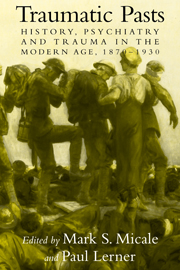Book contents
- Frontmatter
- Contents
- Contributors
- Preface
- 1 Trauma, Psychiatry, and History: A Conceptual and Historiographical Introduction
- Part One Travel and Trauma in the Victorian Era
- Part Two Work, Accidents, and Trauma in the Early Welfare State
- Part Three Theorizing Trauma: Psychiatry and Modernity at the Turn of the Century
- 6 Jean-Martin Charcot and les névroses traumatiques: From Medicine to Culture in French Trauma Theory of the Late Nineteenth Century
- 7 From Traumatic Neurosis to Male Hysteria: The Decline and Fall of Hermann Oppenheim, 1889–1919
- 8 The Construction of Female Sexual Trauma in Turn-of-the-Century American Mental Medicine
- Part Four Shock, Trauma, and Psychiatry in the First World War
- Index
- Titles in the series
6 - Jean-Martin Charcot and les névroses traumatiques: From Medicine to Culture in French Trauma Theory of the Late Nineteenth Century
Published online by Cambridge University Press: 14 October 2009
- Frontmatter
- Contents
- Contributors
- Preface
- 1 Trauma, Psychiatry, and History: A Conceptual and Historiographical Introduction
- Part One Travel and Trauma in the Victorian Era
- Part Two Work, Accidents, and Trauma in the Early Welfare State
- Part Three Theorizing Trauma: Psychiatry and Modernity at the Turn of the Century
- 6 Jean-Martin Charcot and les névroses traumatiques: From Medicine to Culture in French Trauma Theory of the Late Nineteenth Century
- 7 From Traumatic Neurosis to Male Hysteria: The Decline and Fall of Hermann Oppenheim, 1889–1919
- 8 The Construction of Female Sexual Trauma in Turn-of-the-Century American Mental Medicine
- Part Four Shock, Trauma, and Psychiatry in the First World War
- Index
- Titles in the series
Summary
Physicians have long believed that disturbing experiences arouse intense emotions that can cause illness and disease. Similarly, human behaviors that can be interpreted in the diagnostic language of our own time as post-traumatic pathology date back to classical times. The first medical instances of describing, labeling, and treating such behaviors appeared during the seventeenth century, when army doctors typically regarded the cases as an organic disease of an unknown nature, cowardice, or malingering. Traumatic neurosis as a distinct psychiatric category, however, with an independent diagnostic identity and psychological – or mixed somatic and psychological – origins emerged in Western Europe and North America only during the last third of the nineteenth century.
The period 1870–1910 witnessed an unprecedented burst of creative psychological theorizing in Europe and the United States. This was the founding generation of modern psychology, psychiatry, and psychotherapy during which the sciences of the mind largely assumed the theoretical and professional forms in which we know them today. The observation and theorization of psychological trauma played no small part in this intellectual development. One of the first physicians of this period to explore systematically the idea of posttraumatic pathology and to write extensively about it – and who was a direct and demonstrable inspiration to medical traumatologists in the next generation – was the Parisian neuropsychiatrist Jean-Martin Charcot.
THE BACKGROUND TO CHARCOT'S WORK ON TRAUMATIC NEUROSIS
Charcot (1825–1893) studied trauma during the second half of his career, from the later 1870s through to his death in the early 1890s.
- Type
- Chapter
- Information
- Traumatic PastsHistory, Psychiatry, and Trauma in the Modern Age, 1870–1930, pp. 115 - 139Publisher: Cambridge University PressPrint publication year: 2001
- 16
- Cited by

